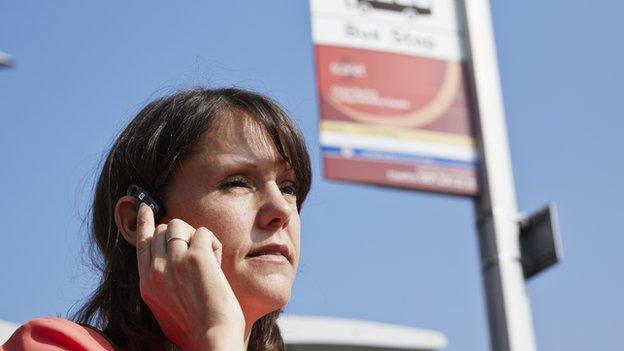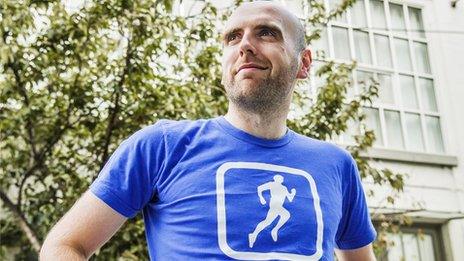Microsoft headset to help blind people navigate cities
- Published
Rory Cellan-Jones puts the headset to the test
A headset that talks visually impaired people around cities has been designed by Microsoft.
It works with a Windows phone and uses location and navigation data with a network of information beacons in urban locations to describe routes.
The headset was tested on a journey from Reading to London, including shopping, bus and train travel.
The charity Guide Dogs, which helped develop the technology, said it could help improve lives.
Of the two million registered visually impaired people in the UK, 180,000 rarely or never go out, according to the charity.
"People living with sight loss face a multitude of challenges every day that can prevent them from getting where they want to be in life," explained Jenny Cook, head of strategy and research at Guide Dogs.
"Currently, visiting a new city is often daunting, even for people with enough confidence to tackle the challenge independently. For others, who rarely leave home alone, the thought of an unfamiliar journey leaves them stressed and anxious and visiting a new area is an impossible dream."

The BBC's technology correspondent Rory Cellan-Jones tested out the headset.
Before trying out Microsoft's headset I put on a blindfold, picked up a white stick and went for a short walk along London's Grand Union Canal.
All the way, I was being helped by a tutor from the Guide Dogs organisation - but even so I found it an exhausting and disorientating experience. That gave me some context for when I used the experimental audio system on the trial route in Reading.
At first I found it distracting rather than helpful, a clippety-clop sound echoing around my head plus a repeated ping to say I was on track. But as I hesitantly made my way down a residential street, across a road and to a bus stop, the instructions - "parked cars and overhanging trees ahead" - gave me added confidence and the 3D sound provided me with a somewhat better feel for my surroundings.
For me it was all about feeling a little less scared - but for the visually impaired people who have been testing the technology for some weeks, it seemed to have increased their confidence in taking new routes up to a new level.

The headset is an adapted version of one already on the market. Designed for cyclists, it sits in front of the ear so as not to drown out traffic and environmental noise.
Sound is conducted through the jawbone and the headset gives a series of verbal and non-verbal descriptions.
For someone who has requested a specific route, it will make a series of clicking noises to assure them they are on the right course and it will provide specific instructions such as "turn right".
It also provides information about the route and points of interest.
Greater freedom

Beacons at bus stops and in shops beam information to the wearer
Eight people with sight loss have tested the headset and five of those reported feeling safer and more confident wearing it.
Kirstie Grice, one of those to trial the technology, said: "We want to live like normal people. We don't always want to plan ahead to see if we can get community transport or a taxi or something, we want to be able to just jump on a bus and go somewhere and have that freedom."
The idea for the headset, which has been designed in partnership with the UK's Future Cities catapult and Guide Dogs, came from a Microsoft employee.
Amos Miller is visually impaired and realised that technology might be able to help him "enjoy everyday experiences outside of the home" after his daughter was born.
Some experts have questioned if the technology is capable of being rolled out widely as it is to rely on a network of beacons attached to street furniture.
A Microsoft spokesman said: "A lot of the information comes from GPS and annotated maps in the cloud which provide as much, if not more than, the beacons."
- Attribution
- Published22 October 2014

- Published9 October 2014
